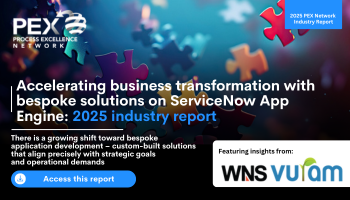Why change management is key to embedding intelligent automation
Geralyn Giorgio, director change management global services North America at Johnson & Johnson, explains why a holistic change management strategy is vital to realizing an organization’s vision and is a key component in digital adoption
Add bookmark
The pandemic has expedited the importance of increasing the role of digital technologies into work culture. To prepare for the future, digital technologies such as intelligent automation (IA) must be embraced early on to reimagine end-to-end processes and be fully integrated into the way that we work. Getting there entails cross-functional collaboration, where all functions play an important role.
Change management is a critical capability which needs to be embedded into the project team at the start of any significant intelligent automation transformation as it provides a framework for assessing the impact of change on people, processes and technology.
Change leaders should use change assessments and data to inform a comprehensive strategy that provides a dynamic and interactive experience designed to not only build new skills but also adopt and sustain new ways of working in a digitized environment. This includes a robust internal communications plan to create awareness and excitement through leadership engagement and training to educate employees about IA prior to the automation going live in their function.
Such an approach will reach employees of all levels and inspire them to embrace intelligent automation — not fear it. Through storytelling, sharing best practices, leadership engagement and targeted intelligent automation training, the transformation becomes real for employees, enabling them to lean into the change and drive adoption, which is the goal of change management. The faster this happens, the greater the impact on business solutions for stakeholders.
Join the PEX Network community

Don't miss any news, updates or insider tips from PEX Network by getting them delivered to your inbox. Sign up to our newsletter and join our community of experts.
Learn MoreChange councils and agents inspire innovation
A best practice when launching an IA program is the formation of an enterprise-wide council comprising of executive sponsors and leaders across all functions to discover cross-functional opportunities. One role of the council is to share learnings and best practices to identify use cases with the highest impact and value. This practice is effective in spurring creativity and healthy competition between functions.
To maintain momentum, a change management strategy will equip sponsors with resources needed to rally the entire workforce into becoming part of the digital transformation. This requires an ongoing commitment to talent development, digital up-skilling and an openness to diverse ideas that lead to greater innovations.
Another best practice in supporting a change strategy for IA is to build a network of change agents from across all functions. These influencers will not only partner with the change team but, more importantly, will champion for positive transformative impacts of IA within their business. This type of advocacy can bring about an organic comfort level that demystifies IA and fosters an understanding that comes from peer-to-peer trust. For this to be successful, the change team should onboard change agents early in the planning stages, establish an ongoing cadence of meetings and equip them with the tools needed to be effective advocates for IA.
At Johnson & Johnson, partnerships enabled the expansion of the IA program across several key functions including commercial, supply chain, R&D, global services, technology, human resources and finance, among others. This helps to ensure the pace is keeping up with external trends to operate at scale.
As a result, the enterprise IA program is delivering on our 3Es — experience, effectiveness and efficiency — giving our employees more time to focus on creative innovations and upskilling. It is enabling the reimagining, simplifying and digitizing processes for customers and other stakeholders, while delivering significant value for the organization.
Transformation is about people, not technology
At J&J we emphasize that automation is done by people for people. An IA program is not about replacing humans with robots, it is about taking robots out of humans by making their work more human and providing a more fulfilling job experience.
Employee adoption is crucial to the success of IA. Once non-value work is automated, employees will be empowered to focus on more meaningful, purpose-driven work, creating a better experience for all stakeholders.
By applying digital-first thinking, teams are reimagining end-to-end processes using advanced automation, accelerating business outcomes by creating substantial value through unique IA solutions and generating impactful insights that help lead to future innovations.
These tools and technologies give us an edge we did not have before, and organizations should be obligated and feel privileged to explore it in this day and time.
Accelerating business transformation with bespoke solutions on ServiceNow App Engine

Today, off-the-shelf software solutions offer diverse features that enable vast opportunities to implement and maintain business transformation. However, in some circumstances, capabilities lack the flexibility and specificity required to address the unique challenges and workflows of individual organizations. As a result, there is a growing shift toward bespoke application development – custom-built solutions that align precisely with strategic goals and operational demands.
Download this report to explore how enterprises can harness the power of custom applications to drive meaningful transformation. With the growing adoption of low-code platforms like ServiceNow App Engine, organizations are building custom applications faster and with greater control. By empowering both IT professionals and citizen developers to build tailored solutions, organizations can significantly reduce time to value while maintaining control over quality and compliance.
Download Now












